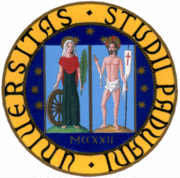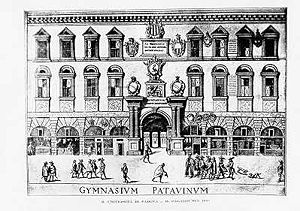| University of Padua |
| Università degli Studi di Padova |
 |
| 拉丁语: Universitas Studii Paduani |
| 校训 |
Universa Universis Patavina Libertas (拉丁语) |
| 英语校训 |
Liberty of Padua, universally and for all |
| 建立于 |
1222 |
| 类型 |
State-supported |
| Rector |
Prof. Giuseppe Zaccaria |
| 学生 |
65,000 |
| 位置 |
Padua, Veneto, Italia |
| Sports teams |
CUS Padova (http://www.cuspadova.it/) |
| 归属 |
Coimbra Group, TIME network |
| 网址 |
www.unipd.it/ |

"Gymnasivm Patavinum:" The University's main Bo palace shown in a 1654 woodcut
The University of Padua (Italian Università degli Studi di Padova, UNIPD, Venetian Università dełi Studi de Pàdoa), located in Padua, Italy, was founded in 1222. It is among the earliest of the universities and the second oldest in Italy. As of 2003 the university had approximately 65,000 students and in 2009 it was nominated as "Best University" among Italian institutions of higher education with more than 40,000 students.
历史
The university was founded in 1222 when a large group of students and professors left the University of Bologna in search of more academic freedom ('Libertas scholastica'). The first subjects to be taught were law and theology. The curriculum expanded rapidly, however and by 1399 the institution had divided in two: a Universitas Iuristarum for civil law, Canon law, and theology, and a Universitas Artistarum which taught astronomy, dialectic, philosophy, grammar, medicine, and rhetoric. (The two were only reunited into one university in 1813.)
The student body was divided into groups known as ‘nations’ which reflected their places of origin. The nations themselves fell into two groups: the cismontanes for the Italian students and the ultramontanes for those who came from beyond the Alps.
From the fifteenth to the eighteenth century, the university was renowned for its research, particularly in the areas of medicine, astronomy, philosophy and law. This was thanks in part to the protection of the Republic of Venice, which enabled the university to maintain some freedom and independence from the influence of the Roman Catholic Church. During this time, the University adopted the 拉丁语 motto: Universa universis patavina libertas (Paduan Freedom is Universal for Everyone). The university had a turbulent history, and there was no teaching in 1237-61, 1509-17, 1848-50.
The Botanical Garden of Padova, established by the university in 1545, was the second such garden in the world, and is the oldest which remains to this day on its original site. In addition to the garden, best visited in the spring and summer, the university also manages nine museums, including the renowned Museum of History of Physics.
Since 1595, Padua's famous anatomical theatre drew artists and scientists studying the human body during public dissections. It is the oldest surviving permanent anatomical theatre in Europe. Anatomist Andreas Vesalius held the chair of Surgery and Anatomy (explicator chirurgiae) and in 1543 published his anatomical discoveries in De Humani Corporis Fabrica. The book triggered great public interest in dissections and caused many other European cities to establish anatomical theatres.
On 25 June 1678, Elena Lucrezia Cornaro Piscopia became the first woman to graduate in history when she was awarded a degree in Philosophy.
The University became one the universities of the Kingdom of Italy in 1873, and ever since has been one of the most prestigious in the country for its contributions to scientific and scholarly research: in the field of mathematics alone, its professors have included such figures as Gregorio Ricci Curbastro, Giuseppe Veronese, Francesco Severi and Tullio Levi Civita.
The last years of the nineteenth and the first half of the twentieth century saw a reversal of the centralisation process that had taken place in the sixteenth: scientific institutes were set up in what became veritable campuses; a new building to house the Arts and Philosophical faculty was built in another part of the city centre (Palazzo del Liviano, designed by Giò Ponti); the Astro-Physics Observatory was built on the Asiago uplands; and the old Palazzo del Bo was fully restored (1938–45). Obviously, the vicissitudes of the Fascist period—political interference, the Race Laws, etc.—had a detrimental effect upon the development of the university, as did the devastation caused by the Second World War and—just a few decades later—the effect of the student protests of 1968-69 (which the University was left to face without adequate help and support from central government). However, the Gymnasium Omnium Disciplinarum continued its work uninterrupted, and overall the second half of the twentieth century saw a sharp upturn in development—primarily due an interchange of ideas with international institutions of the highest standing (particularly in the fields of science and technology).
In recent years, the University has been able to meet the problems posed by overcrowded facilities by re-deploying over the Veneto as a whole. In 1990, the Institute of Management Engineering was set up in Vicenza; then the summer courses at Brixen (Bressanone) began once more; and in 1995 the Agripolis centre at Legnaro — for Agricultural Science and Veterinary Medicine — opened. Other sites of re-deployment are at Rovigo, Treviso, Feltre, Castelfranco Veneto, Conegliano, Chioggia and Asiago.
Recent changes in state legislation have also opened the way to greater autonomy for Italian universities, and in 1995 Padua adopted a new Statute that gave it greater independence.
As the publications of innumerable conferences and congresses show, the modern-day University of Padua plays an important role in scholarly and scientific research at both a European and world level. True to its origins, this is the direction in which the Institution intends to move in the future, establishing closer and closer links of co-operation and exchange with all the world's major research universities.
Eminent faculty and alumni
- Galileo Galilei, Italian physicist, mathematician, astronomer, and philosopher
- Giovanni Pico, humanist
- Pomponio Algerio, student of civil law (1550s) executed under the Roman Catholic Inquisition.
- Nicholas of Cusa
- Pietro Pomponazzi
- Nicolaus Copernicus, astronomer
- Mikołaj Kiczka, Polish noble, diplomat and priest.
- Pietro Bembo, poet and cardinal
- Sperone Speroni
- Moses Hayyim Luzzatto, Kabbalist and playwright. Founder of Hebrew literature.
- Reginald Pole, cardinal
- Andreas Vesalius, anatomist
- Gabriele Falloppio, anatomist
- Daniele Barbaro, translator of Vitruvius
- Ermolao Barbaro, appointed professor of philosophy in 1477
- Francesco Barbaro, humanist
- Marcantonio Barbaro, administrator who established an inclusive admission policy
- Girolamo Fabrici d'Acquapendente
- Torquato Tasso, poet.
- Boris Pahor, writer
- Sir Francis Walsingham
- Pietro Pomponazzi held the chair of natural philosophy from 1495 to 1509
- Jacopo Zabarella held the chairs of logic, and philosophy, from 1564 to 1589
- Guido Panciroli, doctorate 1547; law professor 1547-1570, 1582-1599; first chair of Roman Law in 1554-1570, "afternoon chair" of Civil Law 1556-1570
- François de Sales, doctorate in civil and canon law, summa cum laude et honore plurimo, in 1591, Bishop of Geneva in 1602, canonized 1665
- Cesare Cremonini held the chairs of natural philosophy, and medicine, between 1591 and 1631
- Galileo Galilei held the chair of mathematics between 1592 and 1610
- William Harvey, anatomist.
- Thomas Browne, writer and physician.
- Antonio Vallisneri held the chairs of practical medicine, and theoretical medicine, between 1700 and 1730
- Giovanni Battista Morgagni
- Ugo Foscolo
- Francesco Zantedeschi
- Elena Cornaro Piscopia, the first woman to receive a doctor of philosophy degree
- Giuseppe Tartini, musician and composer
- Giacomo Casanova, traveller, author and seducer.
- Federico Faggin, inventor of modern CPU
- Francysk Skaryna, the printer of the first book in an Eastern Slavic language
List of Faculties
The University of Padova offers a wide range of degrees in 13 faculties:
- Faculty of Agriculture
- Faculty of Humanities
- Faculty of Economics
- Faculty of Education
- Faculty of Engineering
- Faculty of Law
- Faculty of Mathematical, Physical and Natural Science
- Faculty of Medicine and Surgery
- Faculty of Pharmacy
- Faculty of Political Science
- Faculty of Psychology
- Faculty of Statistical Science
- Faculty of Veterinary Medicine
- Faculty of Philosophy
更多
- List of oldest universities in continuous operation
- List of Italian universities
- Padua
- Top Industrial Managers for Europe
参考文献
- ^ "Università degli Studi di Padova - Rettore Prof. Giuseppe Zaccaria" (in Italian). UniPd.it. Università degli Studi di Padova. http://www.unipd.it/organizzazione/organiateneo/rettore.htm. Retrieved 2009-10-26.
- ^ [1]
- ^ The Galileo Project | Chronology | Galileo Timeline
External links
- University of Padua 网址 (Italian) (English) (Spanish)
- Museums of the University
|
|



